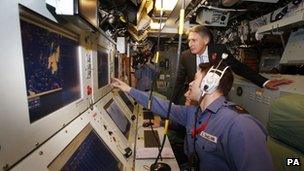Analysis: Jobs supported by the UK's nuclear weapons programme
- Published

The latest spat over the UK's nuclear weapons programme is about the jobs it supports. And as the numbers vary very widely, who's right?
They may all be, as they're counting different things.
Asked for the number of civilians working on the programme, the Ministry of Defence said it was 520.
For those wishing to play down the economic significance to the Clydeside economy, that's the number on which they focus.
But it only counts civilians, and is strictly limited to those working on the missiles.
If you count all those employed on supporting the programme and the four submarines which provide the platform, the number goes above 6,500 jobs.
Of those, the MoD says about 3,500 are uniformed Royal Navy, 1,700 are contractors and 1,600 are other civilian employees.
More are on their way. Two Astute class submarines are already based at HMNB Clyde, and five more are due to follow when they've finished sea trials.
Four older Trafalgar class submarines are having their base moved, so that the whole Royal Navy submarine fleet will be based on the Clyde, from 2017.
The MoD says that should take employment numbers up to about 8,000.
Sent south?
To rewind, an economic consultancy reported for Scottish Enterprise 10 years ago that there is a multiplier effect in the west of Scotland - that is, local businesses supply Faslane and Coulport, and then a portion of the salaries of 6,500 people is spent on local businesses.
That was reckoned to take the number of jobs dependent on the bases to about 11,000.
Would that be a huge blow to the local economy if an independent Scotland sent the submarines south - or, as Alex Salmond has suggested, to bases in France or the US?
Not necessarily. It would be a very tough ask to retain so many jobs at Faslane and Coulport (the nearby base where the missiles are stored) if there were no nuclear submarines.
But if government has that kind of money available, who is to say it couldn't create jobs by spending it on other military or civilian priorities?
Budget questions
Today's visit to the Clyde by Defence Secretary Philip Hammond included a claim of 1,200 jobs currently dependent on the next generation of nuclear-armed submarines.
Most of them are with BAE Systems, which received the second tranche of money - worth £305m - for design work. Other jobs are at Rolls-Royce, where the government is funding a refurbishment programme to prepare it for making the next generation of nuclear reactors that power both nuclear-armed and other submarines.
While we're on the numbers, the cost of replacing the Trident fleet officially still stands at the figure calculated back in 2006, and that is between £15bn and £20bn.
It's not just critics of the nuclear programme that question whether that's still a reasonable figure. The MoD has a terrible record for sticking to budgets, and quite a lot has happened to the economy in the past six years (including, as an aside, an astonishing 66% cost inflation over only fours years in the price of building Aberdeen's Western Peripheral Road).
Next generation
The decision on building the new submarines is scheduled for 2016, after both the referendum on independence, and the next Westminster election, when the differences between the Conservative and Liberal Democrat coalitions parties may no longer need resolved.
The current fleet of four boats is scheduled for retirement by 2028. The American makers of Trident are currently working on extending the life of the missiles, so the same weapons will be on the newer boats.
The extended lifespan of the missiles continues until 2042. And then what?
Well, the MoD isn't saying. The US manufacturers are working on the next generation of the missile system.
But what if they don't complete it? Could that mean four very expensive submarines after 2042, with decades of additional life in them, but no missiles available to carry?
- Published29 October 2012
- Published29 October 2012
- Published25 October 2012
- Published26 September 2012
- Published22 September 2012
- Published18 June 2012